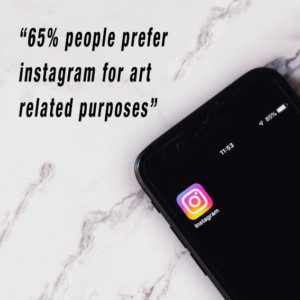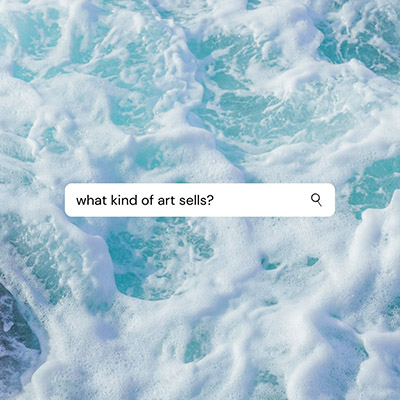
How to sell your art: A seven step guide
How do I start selling my art? This has to be one of the most common questions we hear.
Whether you’ve been doing this for a while or have no idea how to sell your art, this guide has been developed with you in mind.
Regardless of your intentions – either full-time gig or side hustle, thinking like a business owner as well as an artist will likely be the biggest challenge.
This means thinking about things like branding, target audience, website, social media and pricing. Not to mention being very selective about where you invest your time and money.
So, before you set up that website and start posting away on Instagram, let’s go over some of the basics of setting up your art business and how to start selling art.
1. Start with your why
Before you start selling your art, it’s important to get the foundations right.
So, grab a pen and paper, make a tea and get comfortable. It’s time for some self-reflection. We are going to start with your “why”.
Who are you? What motivates you? What do you stand for? Why do you create art? What does it mean to you? How is your art unique?
This is your story. And your story becomes part of your brand.
Story-telling is at the heart of marketing (and social media) and has never been more important. What do we all want? To feel connected. How do we connect with brands and each other? Through stories.
2. Create your brand – be authentic
Developing your brand is key before you start promoting your work.
Yes, as an artist you are your brand. But your brand should encompass your identity as an artist as well as your work, because people will relate to both you and your art.
All the questions you answered above as part of your “why” will form the basis of your brand. Who you are, what you stand for and why you do what you do.
And if there’s one thing all successful brands have one thing in common, its authenticity. And so, when you answer these key questions, keep it real – be honest and you will reap the rewards.
Next steps in creating a brand is to think about your target audience (we go into more detail on this below), your brand personality, business name, logo, look and feel right down to what colours and fonts to use on marketing material, including your website.
Lastly once you’ve defined all of this, remember to keep your brand consistent, in all forms of communication.
3. Define your target audience
Defining your target audience is marketing 101. You need to define your niche and create artwork with this segment of people in mind, because these people are your potential buyers.
Knowing who your buyers are will also determine where you sell your art. After all, business success comes from having the right product available at the right place and time.
How do you determine who your audience is?
Think about the people who have shown interest in your art, or who have bought pieces off you, what are the common characteristics?
Not necessarily demographics like age, gender, job description, location (although this can be helpful too if you can segment your buyers in this way). But think about behavioural traits, attitudes, sense of humour, motivations, are there similar personality traits of the people who are drawn to your work?
If not, think of who you want to create art for and develop an audience persona based on this person/group of people.
4. Social media presence – how to sell your art online
18 million Australians (71% of our population) are now active social media users, and we spend nearly 40 hours per week online, according to research by We Are Social.
“1 in every 3 minutes online is
spent on social media”*
With stats like these, it’s easy to see how social channels like Facebook and Instagram have changed the way we all do business. What’s more, as a business you would be crazy not to be active in this space.
But which channel is right for you when it comes to selling your art?
Twitter, Pinterest, Facebook, LinkedIn, Instagram…there are so many to choose from.
According to the Hiscox Online Art Trade Report 2019 Instagram is the world’s favoured social media platform when it comes to art, with 65% of people electing it as their preferred social channel for art related purposes.
The social channel/s you choose to use will depend on your specific art business, your knowledge and comfort level with usage as well as who your target audience is.
Our recommendation is to pick one or two channels and focus on building an audience and presence there.
A lot of success on social comes from testing and learning. But most importantly, action. You need to start somewhere, with something. So, start posting, and find out what works for you.
5. Build a website
Social media can be used to promote your artwork, but you can’t actually sell (take payment for products) through Instagram and Facebook. These are also not great channels for showcasing your art. The low-resolution images on social channels will not satisfy serious buyers, who will want to see high quality, detailed images of your work.
Luckily, its super easy to create a professional looking website and start selling your art with platforms like WIX and Shopify. With hundreds of templates to choose from and an intuitive set up process, you can be up and running in as a little as day.
However, be sure to think about the scale of your business and where you want to take things. Platforms like WIX are more geared toward smaller e-commerce stores, whereas the likes of Shopify and SQUARESPACE are more suitable for larger operations.
So, do your research and make sure the platform will meet your business goals before jumping in.
6. Growing your business – where to sell your art
With so many avenues available to sell art, how do you choose where to concentrate your efforts? Offline or Online or both?
The 2018 Hiscox Online Art Trade Report revealed almost 50% (4 in 10 art buyers had bought art online in the last 12 months.
What’s even more interesting is who is buying – the report stating 29% of millennial art buyers said they prefer to buy art online vs offline, and this was sharply increasing.
“4 in 10 art buyers bought online
in the last 12 months”^
To exist in the online world, having a social media presence and a basic website is recommended as a minimum.
How much further you go will depend on your appetite, finances, time and target audience (who you are trying to sell too).
If managing the ecommerce part and marketing isn’t your thing, then have a look at online art marketplaces like Bluethumb or Art Lovers Australia. There are also broader online marketplaces, like etsy.com, which are popular among some of our artists.
Of course, there are the traditional offline options to complement your online presence and/or extend reach. These include group art exhibitions, artist trails, art shows like The Other Art Fair or even local markets.
The more aspirational artists will aim to get representation by a gallery or achieve that coveted solo exhibition. There are so many different avenues to explore when it comes to selling your art.
7. Pricing and product – how to scale your business and extend your reach
Will you only be selling originals or are you open to reproduction prints?
When it comes to pricing, of course originals command a higher price tag, but the market of people who can afford and are interested in buying original artworks is very small. Not to mention the amount of time you invest in creating an original artwork – this makes it hard to scale a business.
Essentially, without reproducing you’re looking at a really small market to break into and will only have a small inventory of pieces to sell at any one time. Plus, long periods of time between having a piece to sell. Read more about the benefits of reproducing your work.
Even if you don’t plan to reproduce your work to sell initially, making a quality digital capture of your work should be an essential step of any art business.
Digitising your artwork professionally ensures you have the best possible raw files – for preservation, gallery submissions as well as reproduction prints.
Read more about our artwork scanning service.




